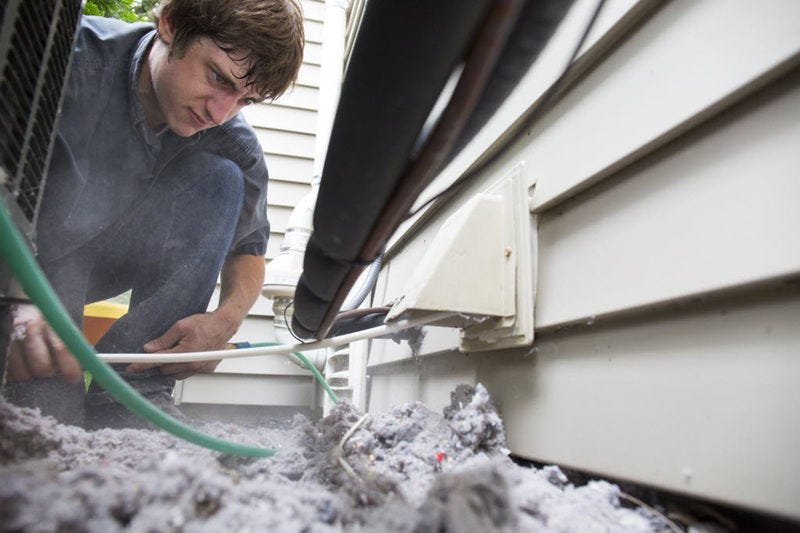Introduction to HVAC Duct Cleaning and Maintenance
It is critical to keep your HVAC (heating, ventilation, and air conditioning) system running smoothly for your home or business comfort. One aspect of this maintenance is cleaning the HVAC duct. With time, dirt, debris, and even mold can build up in ducts, resulting in unhealthy air quality and airflow issues. Not only does it take a toll on the performance of your system, but it can also affect your health because of circulating infected air.
Cleaning your HVAC duct on a regular basis will ensure proper performance of your system with better airflow and indoor air quality. When it comes to HVAC maintenance, most homeowners think about getting their ducts cleaned, but one important aspect that gets overlooked is insulation tape.
If you’re reading this, then that means you’re probably already aware that insulation tape has many important uses in HVAC maintenance, such as sealing air leaks, increasing thermal insulation and improving energy efficiency. But it is an essential element of keeping the entire system happy and optimizing energy performance. We will explore insulation tape on HVAC duct cleaning and general system maintenance in this guide. We will target the likes of air duct sealing, thermal insulation, and upkeep for pre-insulated ducts.
What is Insulation Tape?

Insulation tape is a specialized adhesive product used for sealing, insulating, and protecting ducts in HVAC systems. Insulation tape is made of foil, PVC, or cloth, and the backing has a strong adhesive used to handle temperature changes, air pressures, and moisture conditions of the HVAC system. This is an essential tool for ductwork maintenance.
Common Insulation Tape Types for HVAC Systems
There are different types of insulation tape based on your HVAC system’s requirements. The appropriate tape will be determined by the material of your duct, the temperature it is exposed to, and the actual application.
Foil-backed Insulation Tape
Foil insulation tape is the best option for areas of high temperatures, this helps to provide good thermal insulation to provide hot and cold air system. Its reflective surface keeps ducts from losing all that heat, resulting in a very efficient air within.
PVC Insulation Tape
Because it is flexible and durable, PVC tape also is widely used. Commonly used to seal round ducts and Tubular ducks . PVC tape resists water and retains its integrity at a variety of temperatures, making it a solid option for HVAC systems.
Cloth-backed Insulation Tape
Industrial insulation tape goes up and completely wraps around the edge of the roof. The material is tough, flexible, and perfect for ductwork or areas where extra durability is needed. A strong adhesive available for 3M types you can apply on different duct types easily.
Essential Features of Good Quality Insulation Tape
Selecting insulation for your HVAC ducts, use the following principles:
Durability: The tape should stand up well to wear and tear, particularly in high-traffic areas of the HVAC system.
Incredible Stick: The adhesive needs to bond tightly to ducts, so that the tape stays, even in extreme temperatures and airflow.
Water-resistant: Because HVAC systems are frequently exposed to the elements, the tape must be waterproof and resistant to the degrading effects of heat and cold.
Resistance to Staggering Temperature: From deep-seated cold to high-heat conditions normally experienced in HVAC frameworks, quality protection tape must persevere through the two of these temperature ranges without misplacing its handiness.
What is the use of Insulation Tape for HVAC duct cleaning?

Duct cleaning and duct cleaning maintenance go together, and insulation tape really has everything to do with it. Here’s how insulation tape will help HVAC systems during cleaning and maintenance:
Insulation tape has proven effective in sealing leaks in ducts
One of the most common reasons the HVAC system operates at reduced efficiency is because of leaks in the ducts. The use of insulation tape can also close these holes, keeping the air from leaving the environment and directing conditioned air to where it was supposed to go. This is highly essential in HVAC duct cleaning which may expose leaks during the cleaning process and thus easily identify and seal them.
Thermal Insulation for HVAC Systems
Ducts that are properly thermal insulation play an important role in maintaining temperature. And when ducts lose heat in the winter or cool air in the summer, your HVAC system has to put in extra effort to make up for the lost energy. Using insulation tape, you can minimize heat or cold loss, keep a more comfortable temperature inside and get higher energy efficiency.
Filtration of the Dust and Winds Out There
Even the smallest air leaks can greatly impact your HVAC system’s efficiency. Insulation tape is used to cover the gaps, seams, and joints in the ducts to prevent air leaks. This helps your HVAC system work more efficiently and use less energy, which translates into lower utility bills and longer system life.
Step-by-Step Guide to Using Insulation Tape for HVAC Duct Cleaning
Proper application of insulation tape ensures that it performs at its best. Follow these steps to properly use insulation tape during HVAC duct cleaning and maintenance:
1. Preparing Your HVAC System for Maintenance
Do not forget to turn off your HVAC system before you apply insulation tape, as it keeps any air from flowing during maintenance. This allows you to focus on sealing all of the necessary leaks without interruptions. It is also very important to clean your ducts prior to applying the tape, as debris may affect the adhesion of the tape.
2. Choosing the Right Insulation Tape for Your Needs
Achieving the best results starts with selecting the right insulation tape, which is critical to the entire operation. One must think about the materials used in their ducts, high temperature problem areas, and additionally, if the ducts are pre-insulated. For example, flexible ducts require sealing PVC tape while additional thermal insulation areas require foil backed insulating tape.
3. Applying Insulation Tape: A Simple Step-by-Step Process
Measure the Area: Identify the areas of your ducts that need sealing, such as seams, cracks, and joints.
Cut the Tape to Size: Use scissors or a utility knife to cut the insulation tape to the appropriate length.
Apply the Tape: Carefully apply the tape to the selected areas, ensuring it adheres tightly and no air pockets remain underneath.
Smooth the Tape: Press down firmly on the tape to ensure a secure bond. Smooth out any wrinkles or bubbles to create a tight, durable seal.
The Role of Pre-Insulated Ducts and Duct Sealing

1. Benefits of Using Pre-Insulated Ducts in HVAC Systems
Ducts that come with an insulation layer are referred to as pre insulated ducts. This reduces the amount of insulation required for some areas of the system, although insulation tape is still very important in sealing ducts, seams and joints which increases system efficacy while reducing the risk of air leaks that can develop over time.
2. How Duct Sealing Improves Performance and Energy Efficiency
Duct sealing is an important part of HVAC maintenance. It involves sealing all gaps, seams, and leaks to ensure that the air stays inside the ducts and doesn’t escape. Using insulation tape for duct sealing helps prevent the loss of conditioned air, improving the overall performance of the HVAC system and reducing energy consumption. Sealing the ducts also prevents dust, allergens, and moisture from entering the system, contributing to cleaner, healthier indoor air quality.
Common Issues in HVAC Ducts and How Insulation Tape Fixes Them
1. Fixing Leaks and Cracks in Round Ducts with Insulation Tape
Leaks and cracks in round ducts are common problems that reduce system efficiency. Applying insulation tape to these areas helps prevent air from escaping and ensures the system runs at optimal efficiency.
2. Preventing Mold Growth and Insulating for Duct Insulation
Moisture in HVAC systems can lead to mold and mildew growth inside the ducts. Insulation tape helps prevent this by providing a waterproof barrier that shields the ducts from moisture. Additionally, insulation tape aids in maintaining the overall duct insulation, which is essential for keeping the system energy-efficient and preventing mold growth in the long term.
Conclusion: Why Insulation Tape is Essential for HVAC Maintenance
Adding insulation tape to your HVAC Maintenance plan is a great way to easily boost the performance and lifespan of your system. Insulation tape is essential for sealing leaks, improving HVAC thermal insulation, and HVAC Duct Insulation. Air leaks and energy efficiency can hinder fulfillment of smooth operations of HVAC systems, making the environment being adjusted to remain comfortable yet efficient.
Ensure that your HVAC is regularly checked, tape and ducts are properly maintained, and your HVAC works at optimal performance. Such routine maintenance ensures spending less on energy, increasing system usability, and saving on reimbursement costs.
Taking care of an HVAC system isn’t an easy task, but it is crucial for achieving efficiency, better quality air, and performance longevity. Airlution for example provides a cleansing and repairing service for AC systems in order to keep it cool and working well.
We offer expert services with a focus around contracting, manufacturing and fitting industrial grade ducts that are readily available in round ducts, spiral ducts, and flexible ducts. By employing our superb Duct Cleaning, we facilitate a rise in the quality of indoor air as a result of eliminating dust, allergens, and other harmful entities from the system.
Furthermore, our HVAC Duct Insulation and sealing services help to maintain a well sealed duct system, prevent energy loss, and increase system efficiency. There is no need to worry about clean AC servicing or duct installation, Airlution is your partner for HVAC Company in Saudi Arabia.
Frequently Asked Questions (FAQs)
1. How does insulation tape help in reducing energy costs?
By sealing air leaks in the ducts, insulation tape ensures that the air doesn’t escape, allowing the HVAC system to work less hard to maintain the temperature. This helps lower energy use and reduce your utility bills.
2. Can insulation tape be used on all types of HVAC ducts?
Yes, insulation tape can be used on most types of ducts, including flexible ducts, pre-insulated ducts, and round ducts.
3. How often should I maintain my HVAC ducts using insulation tape?
It is advisable to inspect your HVAC ducts annually for leaks and reapply insulation tape if necessary, especially in areas prone to wear and tear.
4. What is the best time to apply insulation tape in HVAC maintenance?
The best time is during regular maintenance checks or when you are already cleaning your HVAC ducts. This allows you to address any leaks or issues immediately.
5. How long does insulation tape last in HVAC duct systems?
High-quality insulation tape can last several years, but it’s important to inspect it periodically for any signs of wear and tear.


